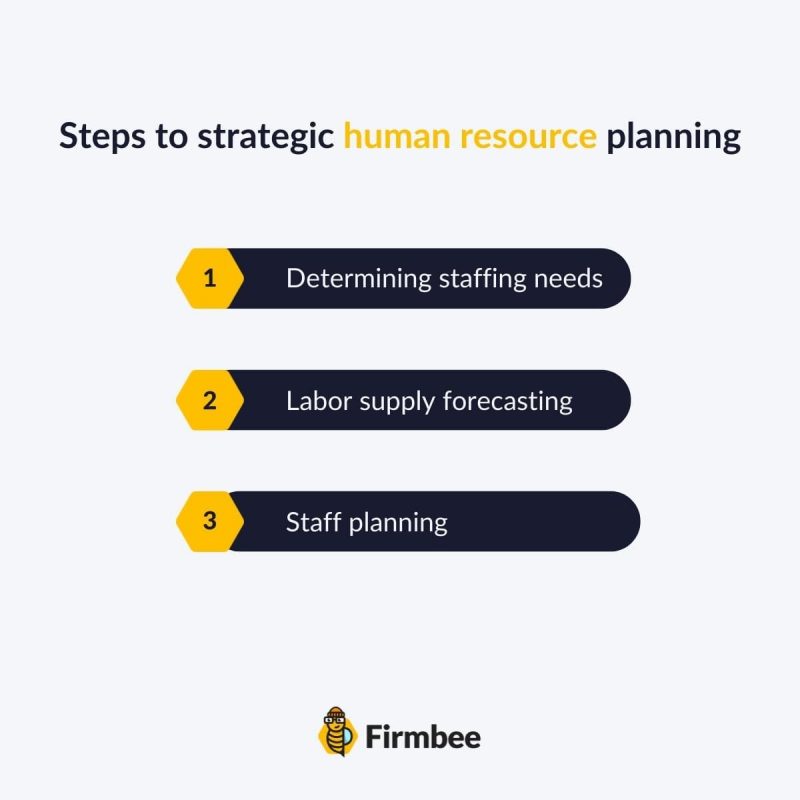What is human resource planning? Human resource planning is an element of HR policy in the organization, as well as the starting point of recruitment and other activities carried out as part of the human resources process. Employees are the key to the efficient functioning of an enterprise. The possibility of obtaining and then maintaining the most competent staff is determined by proper human resource planning. The HRP process relies on the assumption that employees play a crucial role in the organization. It is then essential to align human resources with the company’s needs and goals. Read on.
Human resource planning – table of contents:
What is human resource planning?
Human resource planning can be defined as a continuous process of quantitative and qualitative analysis of staff and then forecasting the future human resource requirements in order to minimize the gap between supply and demand on the internal labor market.
It prevents or reduces the risk of sudden surplus or shortage of staff, and it helps to reduce costs. It also makes it possible to optimize skills, qualifications, and knowledge, and to use them to the fullest to meet the company’s needs.
A distinction between ‘hard’ and ‘soft’ human resource planning can be made. The former is based on quantitative analysis to provide a certain number of suitable employees at the time when they are needed. Soft human resource planning, in turn, concentrates on creating and shaping the organizational culture, which promotes full compliance of the organization’s goals with employee values, beliefs, and behaviors.
The objectives of human resource planning are as follows:
- obtaining and maintaining the required workforce consisting of competent and qualified employees within the organization,
- using staff resources effectively,
- anticipating problems with potential staff shortages and surpluses,
- employee training and development to help personnel adapt to a changing and uncertain external environment,
- separating from external sources of recruitment, creating stabilization plans and staff development strategies to ensure staffing stability.

Steps in strategic human resource planning
Assessing your current staff and uncovering gaps in the critical stage of the HR planning process. Staffing needs depend on the organization’s environment, its internal structure, and a planning period. Taking into account all these variables, we can distinguish three ways to identify staffing requirements, which are presented below:
| Variables | Determining staffing needs |
| Relatively fixed environment and structure of an organization | Short-term planning, updating job descriptions and competency requirements |
| Constantly changing environment and organizational structure | Medium-term planning, updating key job tasks and competency requirements |
| Profound structural changes in an environment and within an organization | Long-term, medium-term and short-term planning, preparing job descriptions using traditional methods, scenario planning |
After determining the competency profiles for particular employees (employee groups), you can proceed to estimate quantitative needs, in order to specify the number of employees necessary to reach the assumed business goals.
These are a few of the factors to consider when deciding how many employees to hire:
- a quantitative and qualitative action plan
- the expected labor productivity
- a level of organization
- a degree of mechanization and automation
- the anticipated production capacity
- legal regulations
Also, when determining your staffing needs, you must consider several aspects related to the variability of the organizational structure, the external environment, and the planning period.
In order to specify your staffing requirements, you can use various calculation methods, for example:
- intuitive methods (a staffing plan, expert estimates, a human resource diagram)
- methods based on time measurement
- mathematical and statistical methods (trend extrapolation, correlation and regression, decision models)
Labor supply forecasting
The second step of human resource planning in the organization is forecasting the supply of human resources, which means predicting future changes in the state and structure of existing employment in quantitative and qualitative terms.
The purpose of a qualitative forecast is to develop the structure of employment at the beginning of the planning period, predict changes and determine the desired state and structure of employment in the future. This approach facilitates the use of employees’ competence profiles, which are analyzed in the initial planning period in relation to the final period.
Quantitative research, in turn, aims to determine the number of staff at the beginning of the period, and then create a forecast at the end of the planning period. In accordance with the statistics in terms of employee admissions, dismissals, and absenteeism, taking into account the liquidity ratio adopted on the basis of experience and the assessment of the situation in the labor market, you can determine quantitative changes in the state and structure of employment.
Labor supply forecasting along with determining staffing needs provides the basis for the development of an employment plan reflecting the surplus or shortage of specific employees, and setting out the directions for action when it comes to workforce optimization over a defined period.
Staff planning
The purpose of staff planning is to distribute tasks among individual employees within the organization by assigning people to existing organizational units, jobs, and activities. Workforce planning seeks to minimize labor costs and maximize employee performance. The employees’ worth can be determined when comparing their competence profiles with the requirements of a given job post.
Apart from the mentioned comparative method, you can also use quantitative and heuristic methods to optimize staffing. Among the quantitative methods, linear programming is the most popular. This technique allows you to optimize a specific objective function, such as maximizing the value of a given employee. The heuristic methods aim to optimize the allocation of staff and jobs on the basis of the employees’ suitability for specific positions.
Human resource planning – summary
Human resource planning (HRP) is important to the company for several reasons. When deployed successfully, it allows managers to optimize the use of the workforce, increase the organization’s productivity and reduce employee turnover.
You’ve just read about the process of human resource planning. Check out our other articles: Career development planning.
If you like our content, join our busy bees community on Facebook, Twitter, LinkedIn, Instagram, YouTube, Pinterest.
Author: Nicole Mankin
HR manager with an excellent ability to build a positive atmosphere and create a valuable environment for employees. She loves to see the potential of talented people and mobilize them to develop.



















